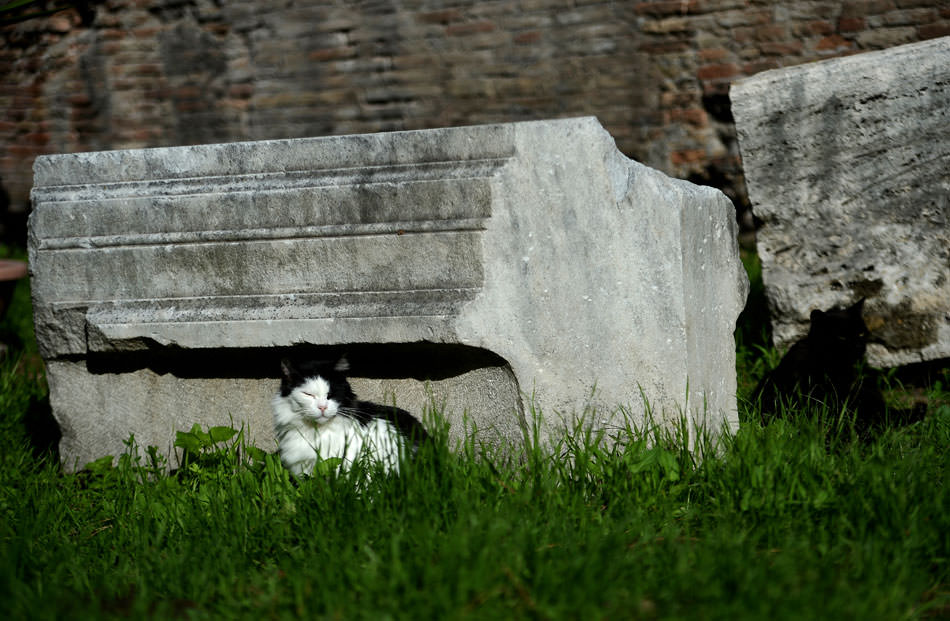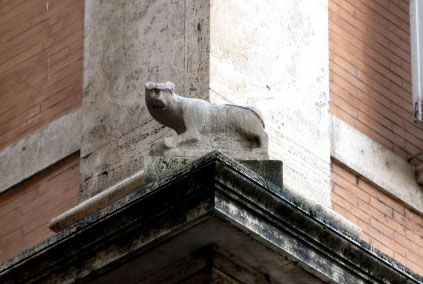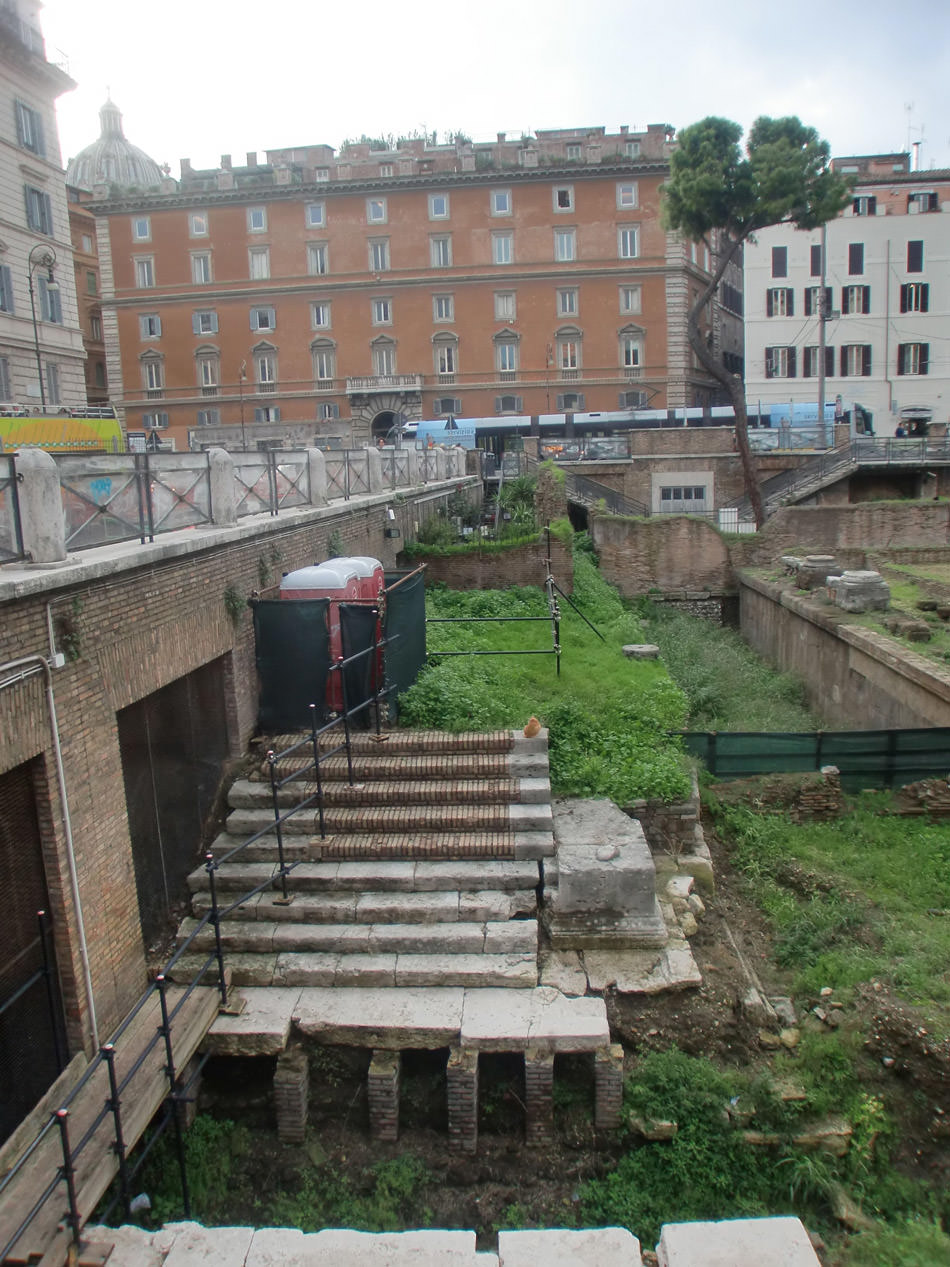Who knows why the Rome edition of the left-leaning newspaper La Repubblica decided to pick on the cat ladies just before Halloween?
Former Italian Prime Minister Silvio Berlusconi must have finally lost all claim to our attention, because La Repubblica has decided to change the target of its latest crusade. Since 1993, a former opera singer named Silvia Viviani has maintained a sanctuary for cats in the center of town, in a Fascist-era archaeological excavation called the Area Sacra di Largo Argentina, or Largo di Torre Argentina. The cat sanctuary has sterilized tens of thousands of animals, healed and vaccinated thousands more. But La Repubblica has suddenly decided to be outraged that cats might find refuge among these unprepossessing ruins.
Largo Argentina has nothing to do with Latin America; this Argentina comes from the Latin name for Strasbourg, Argentoratum (one of whose natives, the fifteenth-century papal master of ceremonies Johannes Burckard, lived down the street). In 1909 the Italian government decided to renovate the area; Renaissance and Baroque buildings were not to contemporary taste. The discovery of parts of a colossal statue in 1926 spurred Mussolini’s archaeologists to mount a large-scale excavation, confident that they would soon be uncovering inspirational monuments of ancient Rome. Two entire city blocks taken up by Renaissance palazzi and the seventeenth-century Baroque church of San Nicola dei Cesarini were smashed to oblivion and razed to the level of sub-basements, to reveal…a resounding disappointment: the broken-down remains of four Roman temples and a bit of the portico of the Theatre of Pompey—the part, as it happened, where Julius Caesar met his end. Unfortunately, the ruins were so ruinous (having been incorporated into later, living buildings) that Mussolini’s archaeologists had to import columns from Ostia Antica to “reconstruct” them. What we see, therefore, is a Fascist-era pastiche set within a network of concrete pylons. One pitiful nubbin of a medieval tower, the Torre del Papito, was heavily restored, along with its glassed-in portico, and both have lain empty—until the cat sanctuary came along.
What La Repubblica finds objectionable is the installation of a cat hospital in the cella of Temple D (so-called because, after eighty years of haggling, archaeologists are unable to agree absolutely that it is dedicated to the Lares Permarini, the household gods who protected sailors). The newspaper has failed to mention that more than half of Temple D’s cella sits under the street, that a series of supporting pylons runs right down the middle of the ruin, and that its original pavement had been drowned in Fascist cement to turn the spaces into storerooms. Nonetheless, the formal charge that has been raised against the cats and their protectors by a series of retired officials (and one official in office, Superintendent of Antiquities Umberto Broccoli)—all men, several of them moonlighting as columnists for La Repubblica—is abuso edilizio, illegal construction.
In a city where abuso edilizio is a way of life, this looks like shooting sparrows with cannon. Cats have been in Italy since the Etruscans brought them from Egypt in the seventh or sixth century BC; for the Romans, they were, on rare occasions, luxury pets for the rich—only one fragmentary cat skeleton has been found in the ruins of Pompeii—and, more commonly, temple cats for the cult of Isis. The cats of Largo Argentina most probably descend from the temple cats who inhabited the great sanctuary of Isis a few blocks down the street. Today, one life-sized marble sculpture of a temple cat sits on the cornice of Palazzo Grazioli, Silvio Berlusconi’s Roman residence, a reminder that these cats are a vital archaeological patrimony in their own right. They even have been designated part of Rome’s “biocultural heritage” by a decree of the city council.
That most of those attacking the cat hospital are retired from powerful positions may explain some of their ire. Otherwise it would be surprising to find left-leaning Adriano La Regina, retired national Superintendent of Antiquities, and Andrea Carandini, retired professor at the University of Rome and recently resigned President of the Supreme Council of Culture, along with Claudio Strinati, retired head of Rome’s “Polo Museale” (the city’s museums), fulminating so loudly in defense of a Fascist eyesore. They seem to have forgotten that Largo Argentina was dirty and neglected when the cat sanctuary moved in during the early 1990s; since the cats came to stay, the piazza, while still a problematic site, has become unexpectedly animated, endlessly amusing, and beautified.
What is it about Largo Argentina that suddenly has these extremely distinguished men so hopping mad? They could be aiming the same concerted fire at epic targets, given the fact that for decades, the Roman countryside, with its ancient villas, tombs, and villages, has been bulldozed by rampant abuso edlilizio, and is still being bulldozed today, the abuses rectified by ex-post-fact condoni, pardons. This destruction has happened in their lifetimes, in the very decades when they had all the power in the world to speak out against it. Why go after the cat ladies and the veterinary hospital that has brought life to the hapless, ugly, hopelessly false Largo Argentina rather than pick on the big developers who have done real damage? It is hard to avoid noting that, like an increasingly large segment of Italian society, the cat sanctuary is run by women, whereas this chorus of critics is ponderously, conspicuously male. Is there some conflict here between feisty women, independent cats, and traditional authority? Irate letters to the editors of local Roman editions of the Italian dailies suggest that there may well be.
Advertisement
In any event, the campaign against the cat sanctuary isn’t working as its initiators must have hoped. La Repubblica may be attacking the Largo Argentina sanctuary in print, but the Internet has been an effective weapon in the cats’ favor (www.romancats.com). Furthermore, blasting so evidently at a group of women has proven an unfortunate tactic in the wake of the sexist excess of the Berlusconi era. Competent women are taking over the archaeological offices of Italy, including Dottoressa Fedora Filippi, a cat owner who has been delegated by the national Superintendency of Antiquities with the thankless task of responding to the outcry about Largo Argentina. The fact is that the culture of cats has changed in Rome, and so has the culture of women—who are no longer willing to listen without being heard themselves. There have also been significant changes to the culture of archaeology, a discipline that has been known to bring in a bulldozer as fast as a shopping-mall developer when patriotism comes calling (as Saddam Hussein did in Babylon).
But in old Europe, the era is gone when scorched-earth excavation, with its displaced residents and overbearingly selective view of history, can be seen as a matter of eminent domain. David Watkin’s recent guidebook to the Roman Forum is the first of its kind to drive home just how much of a living city was destroyed to create today’s Forum, and how much of that archaeological park is a twentieth-century reconstruction of ancient Rome rather than genuine antiquity.
The real urban crime in Largo di Torre Argentina has nothing to do with the cat sanctuary; it has to do with the evisceration of an entire living neighborhood to build an incoherent archaeological site. So fragmentary are the ruins that when people gather in Largo Argentina on the Ides of March, it is to read Shakespeare’s account of Caesar’s death as much as to see the weedy vacant lot where it happened so long ago. Literature is often the place where antiquity lives most indelibly.
On November 8 the volunteers of the Largo Argentina sanctuary met to discuss future plans with members of the city government, guided by City Councilwoman Monica Cirinnà (who inaugurated a new office, Assessor for Animals, under the two previous mayors, unfortunately folded into another office under the present administration), her colleagues, and the city Superintendency of Antiquities. The National Superintendency disdained to participate. Councilwoman Cirinnà was the obvious person for La Repubblica to contact for a second opinion on Largo di Torre Argentina when it started its crusade; after all, she and the paper share a basic political orientation (but of course she is another fierce woman). Paradoxically, it is instead the right-wing Mayor Gianni Alemanno who, along with the 6,500 writers of irate letters to La Repubblica, has come out in defense of the cat hospital. “I’m sorry for all the Superintendents, but my cat (a Chartreux) and I are on the side of Rome’s cats. And woe to those who touch them!” Alemanno tweeted.
The law now prohibits moving cat colonies from their habitat, and so the paladins of a putative archaeological integrity threaten to take the case to parliament. One would like to say “Gentlemen, desist.” But gentlemen don’t pick on cats, or on cat ladies.





